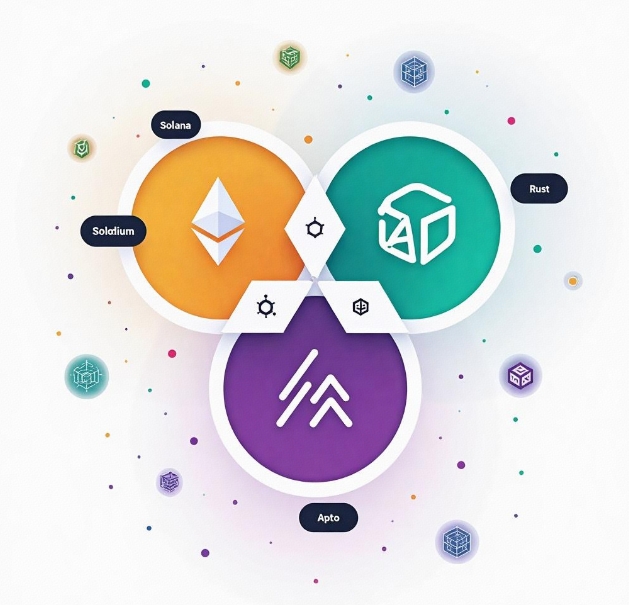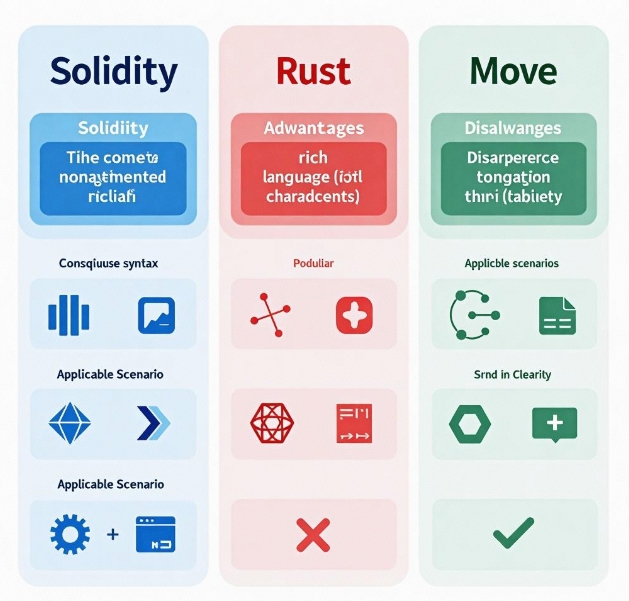Comparison of DApp Development Languages: How to Choose Between Solidity, Rust, and Move?
- latest articles
- 1.DApp Development & Customization: Merging Diverse Market Needs with User Experience 2.Analysis of the Core Technical System in DApp Project Development 3.How to achieve cross-chain interoperability in Web3 projects? 4.How does the tokenization of points reconstruct the e-commerce ecosystem? 5.How to Set and Track Data Metrics for a Points Mall? 6.What is DApp Development? Core Concepts and Technical Analysis 7.Inventory of commonly used Web3 development tools and usage tips 8.Development of a Distribution System Integrated with Social E-commerce 9.Six Key Steps for Businesses to Build a Points Mall System 10.What is DApp Development? A Comprehensive Guide from Concept to Implementation
- Popular Articles
- 1.Future Trends and Technology Predictions for APP Development in 2025 2.Analysis of the DeFi Ecosystem: How Developers Can Participate in Decentralized Finance Innovation 3.From Zero to One: How PI Mall Revolutionizes the Traditional E-commerce Model 4.DAPP Development | Best Practices for Professional Customization and Rapid Launch 5.Recommended by the Web3 developer community: the most noteworthy forums and resources 6.From Cloud Computing to Computing Power Leasing: Building a Flexible and Scalable Computing Resource Platform 7.How to Develop a Successful Douyin Mini Program: Technical Architecture and Best Practices 8.Shared Bike System APP: The Convenient Choice in the Era of Smart Travel 9.How to Create a Successful Dating App: From Needs Analysis to User Experience Design 10.From Design to Development: The Complete Process of Bringing an APP Idea to Life
With the continuous development of blockchain technology, decentralized applications (DApps) have become a core component of the blockchain ecosystem. Developing DApps requires choosing the right smart contract language, and currently, the three most mainstream smart contract development languages on the market are Solidity, Rust, and Move. Each language has its unique characteristics, applicable scenarios, as well as advantages and disadvantages. This article will provide a detailed comparison of these three languages and explore the best choices for different scenarios.
I. Solidity: The Mainstream Language of the Ethereum Ecosystem
1.1 Introduction to Solidity
Solidity is a high-level, contract-oriented programming language developed by the Ethereum team, specifically designed for smart contract development. It is a statically typed language with a syntax style similar to JavaScript and Python, supporting object-oriented programming and library functions, and can run on the Ethereum Virtual Machine (EVM).
1.2 Characteristics of Solidity
Advantages:
Mature Ecosystem: Solidity is the standard language for Ethereum and its compatible chains (such as BSC, Polygon, Avalanche, etc.), with a large developer community and rich tool support (like Truffle, Hardhat, OpenZeppelin, etc.).
Lower Learning Curve: Due to its syntax being similar to JavaScript, many developers can get started quickly.
Comprehensive Smart Contract Development Features: Supports interfaces, inheritance, polymorphism, libraries, events, modifiers, etc., making smart contract logic implementation more flexible.
Powerful Security Tools: There are numerous auditing tools and security libraries (such as Slither, MythX, etc.) available for contract security checks.
Disadvantages:
Security Issues: Solidity has been controversial due to historical major security vulnerabilities (such as the DAO hack, reentrancy attacks, etc.), requiring careful code writing and the use of security libraries.
Average Execution Efficiency: After Solidity code is compiled into EVM bytecode, the runtime overhead is significant, affecting the performance of some high-throughput applications.
1.3 Applicable Scenarios for Solidity
Solidity is mainly suitable for the Ethereum ecosystem and its compatible chains, applicable to scenarios such as DeFi, NFT, DAO, and GameFi. If your DApp's target market is Ethereum and its scaling networks, then Solidity is undoubtedly the best choice.
II. Rust: The High-Performance Web3 Programming Language
2.1 Introduction to Rust
Rust is a systems-level programming language known for its safety and performance. Many emerging blockchain projects, such as Solana, Near, Polkadot, etc., have chosen Rust as the programming language for smart contracts or core protocols. Rust features zero-cost abstractions, memory safety, and support for concurrent programming, making it very suitable for high-performance applications.
2.2 Characteristics of Rust
Advantages:
High Memory Safety: Rust avoids common vulnerabilities such as null pointers, data races, and buffer overflows through its "ownership system," enhancing the security of smart contracts.
Extremely High Execution Performance: After being compiled into WebAssembly (WASM) bytecode, Rust can run efficiently on the WASM virtual machines of chains like Solana and Near, greatly improving execution efficiency.
Multithreading Concurrency Support: Rust provides powerful concurrent programming capabilities, enabling on-chain programs to execute efficiently.
Suitable for Multi-Chain Development: Rust is not only used for smart contracts but is also widely used in blockchain infrastructure development (such as the Polkadot Substrate framework).
Disadvantages:
Steep Learning Curve: Rust's syntax is complex, and its ownership system makes it difficult for many developers to adapt initially.
Ecosystem Still Growing: Compared to Solidity, Rust's toolchain and library support in the smart contract field are relatively limited but are rapidly improving.
2.3 Applicable Scenarios for Rust
Rust is mainly suitable for high-performance, public chain ecosystems, especially the Solana, Near, and Polkadot networks. If your DApp requires high throughput and high concurrency, Rust may be the best choice. For example, DeFi and high-frequency trading applications in the Solana ecosystem are almost entirely developed based on Rust.
III. Move: The Emerging Smart Contract Language
3.1 Introduction to Move
Move is a smart contract language derived from Facebook's (now Meta) Libra project and is currently widely used in the Aptos and Sui blockchains. The design goals of the Move language are security, verifiability, and modularity. It uses a resource model to manage on-chain assets, avoiding many vulnerabilities common in traditional smart contract languages.
3.2 Characteristics of Move
Advantages:
Resource Type System: Move uses "resources" as a fundamental data type, ensuring that on-chain assets cannot be copied or lost, thereby improving security.
Efficient Memory Management: Compared to Solidity, Move's design is closer to Rust, avoiding common security vulnerabilities in smart contracts such as reentrancy attacks.
Suitable for High-Throughput Public Chains: Aptos and Sui use Move as their core language, supporting parallel transaction execution to enhance blockchain throughput.
Modular Development: Move allows developers to create reusable modules, improving development efficiency and code reusability.
Disadvantages:
Ecosystem Still Developing: The Move ecosystem is still in its early stages compared to Solidity and Rust, with fewer development tools, community support, and library richness.
Limited Support on Mainstream Public Chains: Currently, Move is only applicable to Aptos and Sui and has not been widely adopted on other public chains.
3.3 Applicable Scenarios for Move
Move is mainly suitable for emerging public chains (such as Aptos, Sui). If your DApp's target market is these high-performance blockchains, then Move is the best choice. It is applicable to fields such as DeFi, payments, and NFTs, especially for financial applications with extremely high security requirements.
IV. Selection Advice: How to Decide Between Solidity, Rust, and Move?
4.1 Choose Based on Target Public Chain
Ethereum and EVM-Compatible Chains (BSC, Polygon, etc.) → Choose Solidity
Solana, Near, Polkadot → Choose Rust
Aptos, Sui → Choose Move
4.2 Choose Based on Application Type
DeFi, NFT, DAO → Solidity (if based on EVM), Rust (if based on Solana)
High-Performance Financial Applications, GameFi → Rust (Solana), Move (Aptos, Sui)
Payments, Exchanges, Parallel Computing Applications → Move (Aptos, Sui)
4.3 Choose Based on Developer Background
Web2 Developers (familiar with JavaScript/Python) → Solidity
Systems-Level Developers (familiar with C++/Rust) → Rust
Teams with High Blockchain Security Requirements → Move
Conclusion
Different DApp development languages are suitable for different blockchain ecosystems and application scenarios. Solidity is suitable for smart contract development in the Ethereum ecosystem, Rust is suitable for high-performance public chains (such as Solana, Near), and Move has unique advantages on emerging public chains (such as Aptos, Sui). When choosing a language, developers should make the best decision based on factors such as the target public chain, application type, and team skills to ensure the successful implementation and long-term development of the project.
-

DApp Development & Customization: Merging Diverse Market Needs with User Experience
As blockchain technology matures and becomes more widespread, decentralized appl···
-

Analysis of the Core Technical System in DApp Project Development
With the rapid development of blockchain technology, decentralized applications ···
-

What is DApp Development? Core Concepts and Technical Analysis
With the rapid development of blockchain technology, decentralized applications ···

 Blockchain
Blockchain












